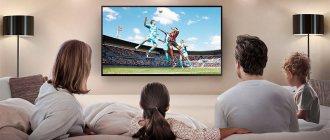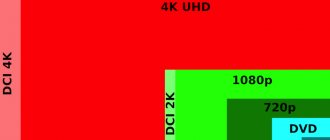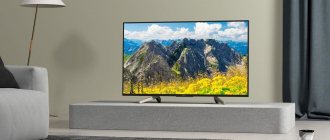When choosing a TV, the user must take into account a large number of factors, including the labeling and technical characteristics of the device. An important characteristic is resolution. A lot depends on what it is, including the quality of viewing. Suddenly one permit is not so different from another, but they still charge a lot of money for it. Is it worth overpaying for a TV that supports full resolution or not? It’s worth looking into this in more detail to understand all the subtleties.
- What is FullHD
- Comparison of HD and Full HD
- What is aspect ratio
- How screen size affects resolution
4:3 resolutions
Recently, this format has given way to new formats such as 16:9 and 16:10.
QVGA - 320 x 240 (4:3) - 76.8 kpix.
VGA 640 x 480 (4:3) - 307.2 kpix.
SVGA 800 x 600 (4:3) - 480 kpx.
XGA 1024 x 768 (4:3) - 786.432 kp.
XGA+ 1152 x 864 (4:3) - 995.3 kpx.
SXGA+ 1400 x 1050 (4:3) - 1.47 megapixels.
HDV 1080i (Full HD Anamorphic Non-Square Pixel) 1440 x 1080 (4:3) - 1.55 MP.
UXGA 1600 x 1200 (4:3) - 1.92 megapixels.
QXGA 2048 x 1536 (4:3) - 3.15 megapixels.
QUXGA 3200 x 2400 (4:3) - 7.68 megapixels.
HUXGA 6400 x 4800 (4:3) - 30.72 megapixels.
Tips for choosing
If the TV is outdated and you are considering purchasing a more advanced model with Full-HD support.
It is recommended to pay attention to the following features:
- Availability of a built-in Wi-Fi tuner and screen mirroring technology. This will greatly facilitate the process of displaying images from other devices.
- Supports satellite and cable tuner. Regular over-the-air channels operate in HD 720px, but via cable or satellite there are a lot of Full-HD programs, incl. and federal broadcasting.
- Matrix technology. If the budget is only enough for an inexpensive LCD TV, its screen should be based on IPS, because TFT matrices are characterized by strong screen illumination.
- Ethernet standard support. It’s more convenient to output from your devices via WiFi, but to receive Full-HD images from a remote server, it’s better to connect to wired Internet, because it has higher speed.
Even TVs of previous generations have a LAN connector for a network cable, but a modern cheap model may not have it.
However, these criteria should be taken into account only when paying attention to Full-HD technology, but when buying a TV it is important to consider other parameters, which are discussed in detail in the topic “Line 4 in the table”.
Table of screen resolutions, aspect ratios and their letter abbreviations:
| Letter abbreviation | Screen resolution (aspect ratio) | Number of pixels |
| QVGA | 320×240 (4:3) | 76.8 kpix |
| SIF(MPEG1 SIF) | 352×240 (22:15) | 84.48 kpx |
| CIF(MPEG1 VideoCD) | 352×288 (11:9) | 101.37 kpix |
| WQVGA | 400×240 (5:3) | 96 kpx |
| [MPEG2 SV-CD] | 480×576 (5:6 — 12:10) | 276.48 kpix |
| HVGA | 640x240 (8:3) or 320x480 (2:3 - 15:10) | 153.6 kpix |
| nHD | 640×360 (16:9) | 230.4 kpix |
| VGA | 640×480 (4:3 — 12:9) | 307.2 kpix |
| W.V.G.A. | 800×480 (5:3) | 384 kpix |
| SVGA | 800×600 (4:3) | 480 kpix |
| FWVGA | 854×480 (427:240) | 409.92 kpx |
| WSVGA | 1024×600 (128:75 — 15:9) | 614.4 kpix |
| XGA | 1024×768 (4:3) | 786.432 kpix |
| XGA+ | 1152×864 (4:3) | 995.3 kpix |
| WXVGA | 1200×600 (2:1) | 720 kpix |
| WXGA | 1280×768 (5:3) | 983.04 kpix |
| SXGA | 1280×1024 (5:4) | 1.31 megapixels |
| WXGA+ | 1440×900 (8:5 — 16:10) | 1,296 megapixels |
| SXGA+ | 1400×1050 (4:3) | 1.47 megapixels |
| XJXGA | 1536×960 (8:5 — 16:10) | 1,475 megapixels |
| WSXGA(x) | 1536×1024 (3:2) | 1.57 megapixels |
| WXGA++ | 1600×900 (16:9) | 1.44 megapixels |
| WSXGA | 1600×1024 (25:16) | 1.64 megapixels |
| UXGA | 1600×1200 (4:3) | 1.92 megapixels |
| WSXGA+ | 1680×1050 (8:5) | 1.76 megapixels |
| Full HD | 1920×1080 (16:9) | 2.07 megapixels |
| WUXGA | 1920×1200 (8:5 — 16:10) | 2.3 megapixels |
| QWXGA | 2048×1152 (16:9) | 2.36 megapixels |
| QXGA | 2048×1536 (4:3) | 3.15 megapixels |
| WQXGA | 2560×1440 (16:9) | 3.68 megapixels |
| WQXGA | 2560×1600 (8:5 — 16:10) | 5.24 megapixels |
| WQSXGA | 3200×2048 (25:16) | 6.55 megapixels |
| QUXGA | 3200×2400 (4:3) | 7.68 megapixels |
| WQUXGA | 3840×2400 (8:5 — 16:10) | 9.2 megapixels |
| 4K (Quad HD) | 4096×2160 (256:135) | 8.8 megapixels |
| HSXGA | 5120×4096 (5:4) | 20.97 megapixels |
| WHSXGA | 6400×4096 (25:16) | 26.2 megapixels |
| HUXGA | 6400×4800 (4:3) | 30.72 megapixels |
| Super Hi-Vision | 7680×4320 (16:9) | 33.17 megapixels |
| WHUXGA | 7680×4800 (8:5, 16:10) | 36.86 megapixels |
We hope that the screen resolutions we have collected in a single table and their abbreviations will be useful to you when choosing a monitor, TV, smartphone, tablet or laptop.
(2)
To understand which screen resolution corresponds to which letter designation, you can use the table below.
The table shows the names (letter abbreviations) of all types of resolutions and corresponding screen aspect ratios. The table starts from the old QVGA and ends with the latest advances in the structure of screen matrices - WHUXGA, which is shown in the photo above. The first column contains the name of the resolution, the second the actual resolution in pixels, the third column indicates the number of pixels. Screen resolutions and aspect ratios:
| Name | Matrix resolution and aspect ratio | Number of pixels |
| QVGA | 320 x 240 (4:3) | 76.8 kpix |
| SIF(MPEG1 SIF) | 352 x 240 (22:15) | 84.48 kpx |
| CIF(MPEG1 VideoCD) | 352 x 288 (11:9) | 101.37 kpix |
| WQVGA | 400 x 240 (5:3) | 96 kpx |
| [MPEG2 SV-CD] | 480 x 576 (5:6 - 12:10) | 276.48 kpix |
| HVGA | 640 x 240 (8:3) or 320 x 480 (2:3 - 15:10) | 153.6 kpix |
| nHD | 640 x 360 (16:9) | 230.4 kpix |
| VGA | 640 x 480 (4:3 - 12:9) | 307.2 kpix |
| W.V.G.A. | 800 x 480 (5:3) | 384 kpix |
| SVGA | 800 x 600 (4:3) | 480 kpix |
| FWVGA | 854 x 480 (427:240) | 409.92 kpx |
| WSVGA | 1024 x 600 (128:75 - 15:9) | 614.4 kpix |
| XGA | 1024 x 768 (4:3) | 786.432 kpix |
| XGA+ | 1152 x 864 (4:3) | 995.3 kpix |
| WXVGA | 1200 x 600 (2:1) | 720 kpix |
| WXGA | 1280 x 768 (5:3) | 983.04 kpix |
| SXGA | 1280 x 1024 (5:4) | 1.31 megapixels |
| WXGA+ | 1440 x 900 (8:5 - 16:10) | 1,296 megapixels |
| SXGA+ | 1400 x 1050 (4:3) | 1.47 megapixels |
| XJXGA | 1536 x 960 (8:5 - 16:10) | 1,475 megapixels |
| WSXGA(x) | 1536 x 1024 (3:2) | 1.57 megapixels |
| WXGA++ | 1600 x 900 (16:9) | 1.44 megapixels |
| WSXGA | 1600 x 1024 (25:16) | 1.64 megapixels |
| UXGA | 1600 x 1200 (4:3) | 1.92 megapixels |
| WSXGA+ | 1680 x 1050 (8:5) | 1.76 megapixels |
| Full HD | 1920 x 1080 (16:9) | 2.07 megapixels |
| Full HD+ | 2340 x 1080 (19.5:9) | 2.3 megapixels |
| WUXGA | 1920 x 1200 (8:5 - 16:10) | 2.3 megapixels |
| QWXGA | 2048 x 1152 (16:9) | 2.36 megapixels |
| QXGA | 2048 x 1536 (4:3) | 3.15 megapixels |
| WQXGA | 2560 x 1440 (16:9) | 3.68 megapixels |
| WQXGA | 2560 x 1600 (8:5 - 16:10) | 5.24 megapixels |
| WQSXGA | 3200 x 2048 (25:16) | 6.55 megapixels |
| QUXGA | 3200 x 2400 (4:3) | 7.68 megapixels |
| WQUXGA | 3840 x 2400 (8:5 - 16:10) | 9.2 megapixels |
| 4K (Quad HD) | 4096 x 2160 (256:135) | 8.8 megapixels |
| HSXGA | 5120 x 4096 (5:4) | 20.97 megapixels |
| WHSXGA | 6400 x 4096 (25:16) | 26.2 megapixels |
| HUXGA | 6400 x 4800 (4:3) | 30.72 megapixels |
| Super Hi-Vision | 7680 x 4320 (16:9) | 33.17 megapixels |
| WHUXGA | 7680 x 4800 (8:5, 16:10) | 36.86 megapixels |
How useful is the article?
Click on the icon to rate:
Average rating: / 5. Number of votes: 2
I'm sorry you didn't like the article...
Let me improve the article.
Thank you for your mark!
From year to year, monitors have improved mainly only in increasing the resolution of the matrix and screen sizes. All this has caused people to strive to view content of ever better quality. Fortunately, production does not stand still, and more and more powerful and advanced computer devices are entering the world market. With their help, this high-quality content is created and broadcast.
Screen resolution 16:9, like 16:10, is the standard for modern times. In this case, the matrix resolution is 1920 x 1080 and 1920 x 1200 pixels, respectively. However, now you should not judge the size of a monitor by its resolution, since even some mobile phones with a screen diagonal of 5 inches have a matrix resolution of more than the FullHD standard (1920 x 1080 pixels).
Modern monitors from the middle price segment, having screen resolutions of 16:9 and 16:10, usually have screens with a diagonal of 22-24 inches. But it was not always so. The optimal screen resolution has varied from time to time.
HD TV signal
When you watch movies on TV, you may notice that the picture quality of digital, cable or satellite television is an order of magnitude lower than the quality of video viewed using a Blu-Ray player. If you think that the problem is that the screen resolution is not large enough, then you are mistaken. The problem is completely different.
Companies that allow their customers to watch up to three thousand channels in HD quality do this in the following way. In order to fit such a large amount of data into a rather dense stream of information, the video signal is very highly compressed, as a result of which the color gradation, sharpness and clarity of the image that was at the beginning practically disappears.
Short story
At the beginning of the history of content creation and playback, the screen aspect ratio was 1:1, that is, “square”. This solution was used only in photography and allowed the composition of the frame to be used both vertically and horizontally. Later, a similar format began to be used when creating films.
The “square” format was replaced by the 5:4 format, which was also called 1.25:1. It was used in some computer monitors and many people confused it with the more common 4:3 format. The only difference was the resolution of 1280 x 1024 pixels. Some “experts” and “professionals” noted a more accurate transmission of geometry on this screen format, but not everyone agrees with this, and the debate is still ongoing.
Immediately after the “square”, in order to expand the visible scene and frame, a 4:3 or 1.33:1 format was created. This format first became widespread in photography and cinema, and then became the standard for analog television broadcasting. You can remember the period when every home had, first, huge wooden and later plastic flat-screen TVs with an almost square screen to receive that broadcast standard. Computer monitors also received this format and for a long time had resolutions of 1024 x 768, 1152 x 864 and 1600 x 1200 pixels. Subsequently, they were supplanted by widescreen devices with a resolution of 16:9.
There were also 3:2 and 14:9 formats. The first did not prove itself to be anything significant, but the second was an intermediate format for the transition from 4:3 analogue television broadcasting to widescreen and easily fit into the old format in the form of small black stripes at the top and bottom of the screen.
The modern 16:10 aspect ratio format has been adopted by computer monitors and a large number of laptops with resolutions of 1280 x 800, 1440 x 900 and 1680 x 1050 pixels per inch. The advantage of this format is a larger working space compared to the most popular one, which has a resolution of 16:9. This format is widely used in gaming monitors.
The transition from analogue to digital television was marked by the creation of a unified high-definition television standard, HDTV, with a 16:9 format. The resolution of the screen matrix in this case is: 1366 x 768, 1600 x 900, 1280 x 720 and 1920 x 1080 pixels. Now there are much more capacious matrices of the same format. What is the difference for the user?
Increasing screen resolution on Windows 7.
Hello dear readers, in today’s article you will learn how to increase the screen resolution on Windows 7, as well as which of them are the most popular, but before we begin, I want to explain what screen resolution is.
This is a value indicating the number of points per unit of a certain area. Typically, this term applies to video files and photographs. Right-click on a free space on the desktop and select “Screen Resolution” from the context menu that opens. After this, a window will open through which you can not only increase the screen resolution, but also find out what image format you currently have. To do this, you just need to expand the menu, in the “Resolution” item.
Here you will see that on my computer the image is within 1680x1050, so we can say that this is the highest value by the standards of my video card and monitor. But if this is not the case for you, you can increase them to the maximum by setting the highest value, however in this case, be careful, when increasing the image format, the speed of the computer (performance) often drops, especially if your computer is weak. And finally, let me write about several of the most popular formats found on computers with the Windows 7 operating system installed:
- 1680x1050 – WSXGA+ is the highest;
- 1600x1200 - UXGA;
- 1600x1024 - WSXGA;
- 1280x1024 - SXGA;
- 1280x720 - HD 720p;
- 800x600 - SVGA, lowest resolution on Windows 7.
OK it's all over Now! Now you know how to increase the screen resolution and next time you can do it yourself, but again I repeat that you should not overdo it, as the speed of the computer may noticeably decrease.
www.yrokicompa.ru
Screen aspect ratio at home and in the office
Nowadays, people use a lot of different computer devices, mobile gadgets and wearable electronic devices both at home and at work in the office. All these technologies are designed to simplify and speed up work, as well as entertain owners.
Screen resolutions of 16:9 and 16:10 are found both in a computer or laptop, and in a TV broadcasting digital content and digital television broadcasting. For fans of computer video games, both of these formats are ideal and they differ only slightly, but TVs usually do not use 16:10 formats.
For workers who deal with spreadsheets, text, or 3D modeling and drawings, having a slightly taller vertical screen (16:10 versus 16:9) allows for valuable additional work and viewing space, resulting in better work.
How to increase screen resolution on a laptop -
Increasing screen resolution is not an easy procedure, which often forces the user to use outside help during its implementation. There are often situations when a laptop user accidentally changes the screen (matrix) resolution by pressing a combination of hot keys, or, for ease of use, selects the one that suits his needs.
Ways to increase matrix resolution on a laptop
Note! Each specific model has its own “ceiling” of the highest resolution.
Content is important
Having a monitor with a 16:9 screen, you also need to have digital content itself. It is created both on video and photo recording devices, and on the computer devices themselves. In the modern world, the media world is being adjusted to FullHD and 4K standards with a 16:9 resolution, since, by unifying content, equipment and content manufacturers abandon non-standard solutions in favor of generally accepted standards. Such actions made it possible to reduce costs for the development of new formats and their implementation, as well as free up production resources for improving and improving products in other areas.
Resolution scaling
Now let's define "scaling". Imagine playing a 1080p movie on a 2160p (4K) display. A 4K screen has four times the total number of pixels, so you can fit four frames of a 1080p image into a 2160p frame natively. This means you need to enlarge a 1080p image four times to fill a 2160p screen.
In practice, this works well because 1080p content is evenly divided into 2160p. When such perfect separation is not possible, scaling techniques must be used that estimate pixel values, further degrading the final image.
While modern upscaling techniques are much better at maintaining image quality, when choosing the resolution of your content, aim for either native content or content that is evenly divided by the screen resolution for the best upscaling results.
For lovers of quality cinema and computer games
Modern monitors with aspect ratios of 16:9 and 16:10 for connoisseurs of gaming and film content do not allow you to fully immerse yourself in the digital world, since they are limited by the viewing width, and the human eye perceives much more with its peripheral vision. For this purpose, developers of monitors and televisions have created special series of their devices with very wide screens. They received an aspect ratio of 21:9 and resolutions of 2560 x 1080 and 3440 x 1440.
- Tutorial
Tablets and smartphones are equipped with screens with different aspect ratios and different pixel densities, but these parameters are rarely indicated in the technical specifications. Let's try to figure out all the tricks associated with these parameters. Let's start with tablets. Here is the ratio of screen sizes used in most modern tablets.
Notice how an 8″ screen with a 4:3 aspect ratio is visually larger than a wide 7″ screen. And the wide 10.1″ screen is one centimeter smaller in height than the 9.7″ screen. I have tabulated the parameters of the screens most often used in tablets.
Text on screens with low PPI (dots per inch) is not comfortable to read. I would not buy a tablet with a screen that has a PPI lower than 150. Even the 164 PPI of the iPad mini screen seems insufficient to many. Screens with a PPI of more than 200 are perceived well. It was a great discovery for me that a 9.7″ 1024×768 screen has an even lower PPI than a 7″ 800×480 screen. Modern smartphones use screens with different aspect ratios (3:2, 5:3, 16:9), but they are all pretty close. In the picture I illustrated the ratio of screen sizes with the same diagonal and different aspect ratios.
The table of screens used in smartphones looks impressive.
As you can see from the table, there are very few screens with low PPI. Of course, you should not buy a smartphone with a screen with a pixel density below 170 PPI. But again, it is better for this figure to be above 200. The vast majority of screens have a square pixel, so the aspect ratio of the screen can be calculated by knowing the number of pixels in width and height. There are only two exceptions - the “wrong” tablet screens with rectangular pixels are 800x480 (should be 800x500) and 1024x600 (correctly should be 1024x640). I spent the evening creating these pictures and tables primarily for myself. I hope that they will be useful to you too. Tables in the excel file: nadezhin.ru/lj/ljfiles/screen.xls upd.: Tables of resolutions and ppi of many devices: en.wikipedia.org/wiki/List_of_displays_by_pixel_density Ppi calculator: members.ping.de/~sven/dpi.html .
Sources used:
- https://admin-gu.ru/other/osnovnye-rashirniya-i-formaty-ekranov
- https://www.scp-garant.ru/service/news/razreshenie_jekranov_sootnoshenie_storon/
- https://texnoblogger.com/razresheniya-ekrana/
- https://fb.ru/article/192207/razreshenie-sootnoshenie-storon-ekrana-monitorov-raznyih-formatov
- https://habr.com/post/169141/
SHARE Facebook
- tweet
Previous articleStep-by-step instructions for installing Yandex.Store
Next articleThumbnails folder on your phone, computer – why is it needed, how to delete it
SIMILAR ARTICLESMORE FROM THE AUTHOR
What to do if the Play Store asks for a promotional code and where to get it - we get rid of problems by making purchases on Google Play
Infrared transmitter for smartphone
Download Iron Marines for android 1.5.5
LEAVE A REPLY Cancel reply
What monitor resolutions are there?
It is determined by the maximum value that is supported by the laptop matrix. Attempts to increase the resolution to values not supported by the matrix can lead to its damage and further incorrect operation. By the way, replacing a laptop matrix is one of the most expensive PC repairs.
Each operating system has a utility for setting screen resolution;
1. In order to use it, go to the Desktop, right-click on any free space.
2. Next, in the menu that opens, select “Properties”, “Screen resolution”;
You can also use the following alternative and no more complicated path: “Start/Control Panel/Display/Screen Resolution”. This path to the utility may vary slightly depending on the OS version used;
3. Select the most suitable resolution by moving the slider.
It is not always possible to achieve what you want using this method: in most cases, the user does not have the opportunity to select the maximum resolution due to the fact that the system cannot recognize the technical parameters of the installed matrix.











